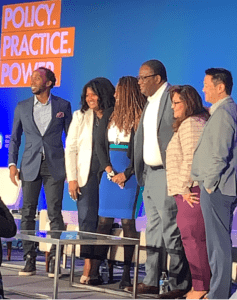

What we have won thus far is getting band-aids. What we haven’t really won on is implementing systemic and institutional change, which we all recognize we need to do.
Lisa Rice, CEO, National Fair Housing Alliance
Earlier this month, community land trust advocates gathered in Washington, DC, to assess the state of the national affordable housing movement. A year ago, hopes were high that the federal government might make transformative investments in affordable housing. Now, the tone was different. “It is struggle. It’s a journey. It will be a marathon,” noted Tony Pickett, CEO of Grounded Solutions Network, the organization that sponsored the conference.
This month’s conference marks the first national gathering since the fall of 2019, when advocates came to Georgia to commemorate the 50th anniversary of the community land trust movement in Southwestern Georgia near Albany. The theme of this year’s conference was “policy, practice, and power” and how these three legs of the movement could be more effectively brought together to achieve housing justice.
In his keynote address, Brookings Institution economist Andre Perry addressed how real estate has reinforced the racial wealth gap, in particular highlighting how anti-Black racism deflates housing values in majority Black neighborhoods. Building off of a 2018 report for which he was the lead author, Perry explained that anti-Black racism—even after controlling for education levels and neighborhood amenities—reduced the net values of homes in Black-majority neighborhoods by an average of $48,000 per household, a 23-percentage-point gap, which works out to a loss of wealth equal to $156 billion nationwide. One of the mechanisms that drives this gap, Perry added, is a white-dominated appraisal industry. That said, Perry clarified that the cause of the gap “is not just about appraisers. There are lenders, real estate agents involved.”
Perry pointed out that if the $156 billion gap—twice the annual economic cost of the US opioid crisis—were closed, that would be enough to capitalize the startup of 4.4 million Black-owned businesses. Note that as of 2019 there were only 3.25 million Black-owned businessesPerry also spoke about an upcoming study he is conducting on commercial property values in Black-majority neighborhoods, which demonstrates similar patterns. In fact, Perry said, preliminary data shows that the loss of commercial property equity in Black majority neighborhoods is even greater than the $156 billion gap in residential values.
What can change those numbers? This question was at the heart of many of the discussions that followed. At the conference, two central themes emerged, somewhat in tension with one another. On one hand, it was clear that since the COVID-19 pandemic, housing advocates have secured a number of policy wins—the most in a generation. And yet, the gap between the resources committed to date and actual need remains daunting.
For example, earlier this year, Housing NOLA, a coalition of New Orleans housing advocates, published a report assessing what it would cost to achieve widespread housing affordability in metro New Orleans. The research team’s answer: $37 billion over 10 years. The population of New Orleans is under 400,000 people, a minute percentage of the US population. Even acknowledging that the housing gap in New Orleans is particularly severe, meeting housing needs at a national level would likely cost well over one trillion dollars.
Such an investment, however, would be financially doable—indeed, much larger federal allocations once were routine. In the late 1970s, the US federal government spent (in inflation-adjusted dollars) at least $200 billion a year more on housing than today, as this federal government budget chart from the National Low-Income Housing Coalition illustrates. But even the much more limited $150 billion commitment contained in the multiyear Build Back Better legislation of President Joe Biden, as approved by the US House of Representatives last November, has been blocked in the US Senate. The main obstacle, in short, is political.
Andreanecia Morris, Executive Director of Housing NOLA, argued that despite the obstacles, advocates must voice the actual need, rather than reduce their ask to more “realistic” demands. “We have our numbers down cold!” Morris exclaimed. She added, “It will take $37 billion to address housing crisis.…Don’t ever let people tell you that your community won’t be given that. Doesn’t your community deserve investment?”
Pandemic Lessons
Of course, housing policy today takes place in the context of an ongoing pandemic. When it began, the COVID-19 pandemic, noted Tony Pickett, CEO of Grounded Solutions Network, “was unchartered territory. There was no best practice.” Collaboration among organizations through the informal CEO Circle network was critical, Pickett added. “We have become a village across our organizations. We trust each other in a way that we hadn’t gotten to before. I look at that as a great outcome in terms of moving the work forward collectively.”

Beyond PPP, coming together, notes Rice, helped advocates secure “band-aids that we did not get with the Great Recession. We did convince our Republican stakeholders that this time around, in addition to corporations, we have to help people. We got things through… [such as] rental assistance, homeownership, childcare”—with the largest commitments made in the American Recovery Plan Act (ARPA) legislation passed last year.
From there, collaboration among CEO Circle members has proceeded, as Dr. Akilah Watkins, CEO of the Center for Community Progress, put it, “from this place of being defensive to reimagining what a future for our communities might look like.” Watkins added that “having a deep level of flexibility has been our superpower.”
For the Build Back Better legislative package, a five-group coalition consisting of Smart Growth America, the National Fair Housing Alliance, the Center for Community Progress, Grounded Solutions Network, and Habitat for Humanity came together and cosigned onto the housing element of the bill. (NeighborWorks America, a congressionally chartered organization, legally couldn’t directly participate).
Watkins emphasized that although Build Back Better has not passed, having “five national organizations working together for affordable housing and having shared equity and community land trusts as a major part of that is a big deal. That spirit doesn’t leave us.” Watkins noted that in addition to achievements at the federal level, there had been state legislative gains. Public land banks, she said, have scored policy wins in Nebraska, Texas, and West Virginia. In Colorado, Urban Land Conservancy CEO Aaron Miripol said in a public comment that advocates there had gotten the state to dedicate $400 million in ARPA funds for affordable housing.
At the conference, many speakers also retained hope that at least some elements of the housing measures that were contained in the Build Back Better legislation might yet become law. One measure that was emphasized was the Restoring Communities Left Behind Act, which, if passed at the amount proposed in the legislation, would create a 10-year, $5 billion a year grant program at the US Department of Housing and Urban Development that would support public acquisition of land through land banks, as well as provide the first direct federal support for permanently affordable housing through community land trusts.
Speaking at the conference, Representative Rashida Tlaib (D-MI) and an author—along with Marcy Kaptur (D-OH)—of the bill, called on advocates to “keep moving forward” and continue knocking on the doors of federal officials. “Folks move with urgency and fund wars,” Tlaib noted. “There is a war on poverty here that we need to address.”
From Policy to Power
In a Washington, DC-based conference, it is understandable that much of the focus was on policy. But speakers also recognized that building the practice of community ownership and community power were critical areas where the movement needed to develop. Marietta Rodriguez of NeighborWorks America pointed out that property ownership and power are often linked. Rodriguez added that her organization works with ROC USA [ROC stands for “Resident-Owned Communities”], “which works with mobile home residents, taking power and control over their proprieties.” Community ownership, she notes, means that residents “have, not the permission, but the right to exercise their voice.”
To date, the ROC USA network reports that it has converted 292 mobile home parks to cooperative ownership, benefiting an estimated 20,154 households. Community land trusts, in which a community nonprofit holds the land, typically through a 99-year renewable ground lease that ensures perpetual affordability, are also growing, with about 15,000 houses owned by families on community-held land, as well as another 20,000 rental units.
At the conference, many attendees also went on a bus tour to visit Douglas Community Land Trust, a nonprofit centered in the Anacostia neighborhood of Southeast Washington, DC, that was first organized in 2017 and incorporated in 2019 as part of a community plan to stave off gentrification. Already, the nonprofit has grown to provide housing for 219 families, the majority of whom are co-owners of their homes through limited equity housing cooperatives.
For his part, Calvin Gladney of Smart Growth America emphasized how policy, practice, and power should be coordinated with each other. As an example, he talked about a partnership of his national group with residents who are developing a community-owned fish market in the North End neighborhood of Newport, Rhode Island, a historically African American community.
The work, Gladney noted, is not fast. “We spent a year working with the community to create a working group. We created a steering committee. People had to fight their way into the working group. After the group was selected, we did a series of trainings, and a lot of it focused on zoning.” Community groups were encouraged to “Stop fighting the refs. Fight the rules.” Gladney added, “We wanted to train them on what the rules are and how to fight for them. If you want to advance racial equity, here are the things that you fight on the zoning rules, so you don’t have to fight on each project. Not just affordable housing but set asides for local entrepreneurs.” The approach worked. As Gladney related, “The community members—they went to the city council hearings, they worked with a local lawyer to get the language into city policy.”
Watkins noted that moving from policy to power ultimately requires a paradigm shift. Helping people “see themselves as active actors in their own communities is so much of our work,” she noted. Watkins added that the history of civil rights struggle is a key resource in this work: “We know how to build relationships. We know how to lead from the back. That is one of the benefits of being from an oppressed group. We have had to develop those skills for many generations.”
Pickett concurred. Lifting up the work of Dr. Shirley Sherrod, Pickett noted that the history of community land trusts began “with Black farmers who are suffering from racism and oppression in the Deep South. They had to radically reimagine their way out of that pain, and they created a new model for collective ownership.” The work, Pickett emphasized, is to help local communities “exercise their imaginations.” He added, “If we can approach it with that mindset every time, we will come out of it at a much better place.”


0 Commentaires